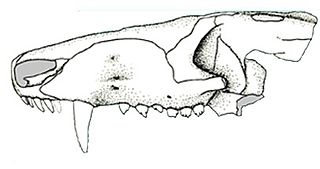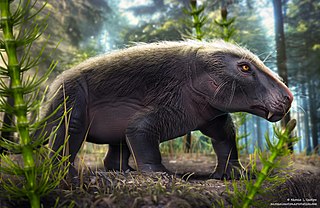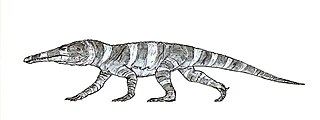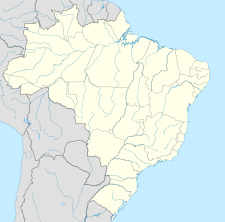
Staurikosaurus is a genus of herrerasaurid dinosaur from the Late Triassic of Brazil, found in the Santa Maria Formation.

Unaysaurus is a genus of unaysaurid sauropodomorph herbivore dinosaur. Discovered in southern Brazil, in the geopark of Paleorrota, in 1998, and announced in a press conference on Thursday, December 3, 2004, it is one of the oldest dinosaurs known. It is closely related to plateosaurid dinosaurs found in Germany, which indicates that it was relatively easy for species to spread across the giant landmass of the time, the supercontinent of Pangaea.

Prozostrodon is an extinct genus of probainognathian cynodonts that was closely related to the ancestors of mammals. The remains were found in Brazil and are dated to the Carnian age of the Late Triassic. The holotype has an estimated skull length of 6.7 centimetres (2.6 in), indicating that the whole animal may have been the size of a cat. The teeth were typical of advanced cynodonts, and the animal was probably a carnivore hunting reptiles and other small prey.

The Santa Maria Formation is a sedimentary rock formation found in Rio Grande do Sul, Brazil. It is primarily Carnian in age, and is notable for its fossils of cynodonts, "rauisuchian" pseudosuchians, and early dinosaurs and other dinosauromorphs, including the herrerasaurid Staurikosaurus, the basal sauropodomorphs Buriolestes and Saturnalia, and the lagerpetid Ixalerpeton. The formation is named after the city of Santa Maria in the central region of Rio Grande do Sul, where outcrops were first studied.

Proterochampsa is an extinct genus of proterochampsid archosauriform from the Late Triassic of South America. The genus is the namesake of the family Proterochampsidae, and the broader clade Proterochampsia. Like other proterochampsids, Proterochampsa are quadruped tetrapods superficially similar in appearance to modern crocodiles, although the two groups are not closely related. Proterochampsids can be distinguished from other related archosauriformes by characters such as a dorsoventrally flattened, triangular skull with a long, narrow snout at the anterior end and that expands transversally at the posterior end, asymmetric feet, and a lack of postfrontal bones in the skull, with the nares located near the midline. Proterochampsa is additionally defined by characters of dermal sculpturing consisting of nodular protuberances on the skull, antorbital fenestrae facing dorsally, and a restricted antorbital fossa on the maxilla. The genus comprises two known species: Proterochampsa barrionuevoi and Proterochampsa nodosa. P. barrionuevoi specimens have been discovered in the Ischigualasto Formation in northwestern Argentina, while P. nodosa specimens have been found in the Santa Maria supersequence in southeastern Brazil. The two species are distinct in several characters, including that P. nodosa has larger, more well-developed nodular protuberances, a more gradually narrowing snout, and a higher occiput than P. barrionuevoi. Of the two, P. nodosa is thought to have less derived features than P. barrionuevoi.

Diodorus is a genus of silesaurid dinosauromorph that lived during the Late Triassic in what is now Morocco. Fossils were discovered in the Timezgadiouine Formation of the Argana Basin, and were used to name the new genus and species Diodorus scytobrachion. The genus name honors the mythological king Diodorus and the ancient historian Diodorus Siculus; the specific name is ancient Greek for 'leathery arm' and also honors the mythographer Dionysius Scytobrachion. The holotype specimen is a partial dentary bone (front of the lower jaw), and assigned specimens include isolated teeth, two humeri (upper arm bones), a metatarsal (foot bone), and femur (thigh bone).
Aetobarbakinoides is an extinct genus of stagonolepidid aetosaur known from the Late Triassic of Rio Grande do Sul state, southern Brazil. Fossils have been found from the Santa Maria Supersequence of the late Carnian and early Norian stages, making Aetobarbakinoides one of the oldest aetosaurs. The type species, A. brasiliensis, was named in 2012, and is notable for being described primarily by features of the vertebrae; most other aetosaurs are diagnosed by features in bony plates called osteoderms, which are by far the most common material. Although placed in a basal phylogenetic position among aetosaurs, Aetobarbakinoides is closely related to both desmatosuchines and typothoracisines, two derived clades of aetosaurs.

Ignotosaurus is an extinct genus of silesaurid dinosauriform known from the Late Triassic (Carnian) Cancha de Bochas Member of the Ischigualasto Formation in the Ischigualasto-Villa Unión Basin in northwestern Argentina. It was therefore contemporary with early dinosaurs such as Herrerasaurus, and lived in the same place.
Dagasuchus is an extinct genus of pseudosuchian archosaur from the Late Triassic (Carnian) of Rio Grande do Sul, Brazil, represented by the type species Dagasuchus santacruzensis. D. santacruzensis was named in 2015 on the basis of a partial hip found in an exposure of the Santa Maria Formation in the Paraná Basin, near the city of Santa Cruz do Sul. Dagasuchus is an early member of a large evolutionary group called Loricata, which originated in the Triassic and includes modern crocodylians and their ancestors. Features of its hip closely resemble those of other early loricatans such as Stagonosuchus and Saurosuchus. Dagasuchus is notable for being the first loricatan found in the Santacruzodon assemblage zone of the Santa Maria Formation; previously loricatans were only known from the older Dinodontosaurus assemblage zone and the younger Hyperodapedon assemblage zone within the Santa Maria Formation, meaning that Dagasuchus fills in a gap in the fossil record of the group.

Buriolestes is a genus of early sauropodomorph dinosaurs from the Late Triassic Santa Maria Formation of the Paraná Basin in southern Brazil. It contains a single species, B. schultzi, named in 2016. The type specimen was found alongside a specimen of the lagerpetid dinosauromorph Ixalerpeton.
Ixalerpeton is a genus of lagerpetid avemetatarsalian containing one species, I. polesinensis. It lived in the Late Triassic of Brazil alongside the sauropodomorph dinosaur Buriolestes.

Siriusgnathus is a traversodontid cynodont from the Carnian channel sandstones and mudstones of the Candelária Formation, belonging to the Santa Maria Supersequence of the Paraná Basin in southeastern Brazil. It includes one species, Siriusgnathus niemeyerorum and was described in 2018. The species epithet refers to the Niemeyer locality in Agudo, Rio Grande do Sul. It was found together with various archosauromorphs, dinosauromorphs and other cynodonts, such as Brasilitherium riograndensis, Brasilodon quadrangularis, Irajatherium hernandezi and Prozostrodon brasiliensis.

Macrocollum is a genus of unaysaurid sauropodomorph dinosaur that lived during the Late Triassic period in what is now Brazil. It is one of the oldest dinosaurs known.

Nhandumirim is a genus of basal sauropodomorph dinosaur from the Carnian age of Late Triassic Brazil. It is currently considered a saturnaliid sauropodomorph. The type and only species, Nhandumirim waldsangae, is known from a single immature specimen including vertebrae, a chevron, pelvic material, and a hindlimb found in the Santa Maria Formation in Rio Grande do Sul.

Dynamosuchus is an extinct genus of pseudosuchian archosaurs from the family Ornithosuchidae. It is known from a single species, Dynamosuchus collisensis, which is based on a partial skeleton from the Santa Maria Formation of Brazil. Dynamosuchus is considered a close relative of Venaticosuchus, which is known from the Ischigualasto Formation of Argentina. Ornithosuchids are one of many groups which lived in the Santa Maria and Ischigualasto Formations, which formed at approximately the same time and were ecologically similar. As a large scavenging reptile, Dynamosuchus helps to illuminate the trophic structure of the Santa Maria Formation. It also supports the hypothesis that ornithosuchids had diversified throughout South America by the start of the Carnian, and were not originally endemic to the Ischigualasto-Villa Unión Basin.
Erythrovenator is a genus of basal theropod dinosaurs from the Late Triassic of Rio Grande so Sul, Brazil. The genus contains a single species, Erythrovenator jacuiensis.

Maehary is a genus of archosaur from the Late Triassic (Norian) Caturrita Formation of Rio Grande do Sul, Brazil. The genus contains a single species, M. bonapartei, known from a partial skull and fragmentary postcrania.
Gamatavus is a genus of silesaurid dinosauriform from the Middle Triassic Santa Maria Formation of Dilermando de Aguiar Municipality, Brazil. The genus contains a single species, G. antiquus, known from a partial ilium. Gamatavus represents the oldest silesaurid known from South America.

Stenoscelida is a genus of proterochampsid archosauriforms from the Late Triassic Santa Maria Supersequence of Rio Grande do Sul, Brazil. The genus contains a single species, S. aurantiacus, known from a right hind limb.

Venetoraptor is an extinct genus of lagerpetid archosaurs from the Late Triassic Santa Maria Formation of Rio Grande do Sul, Brazil. The genus contains a single species, V. gassenae, known from a partial skeleton.




















